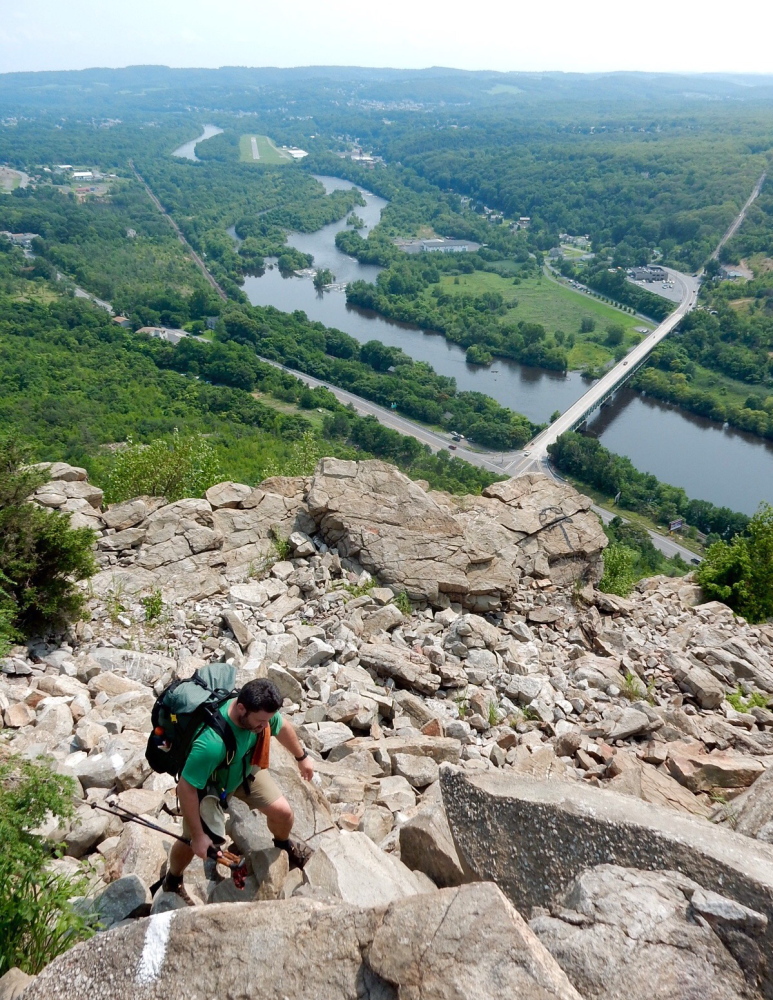As Bill Bryson notes in his best-selling book, “A Walk in the Woods,” the Appalachian Trail in Pennsylvania is “where boots go to die,” and further, “lots of people leave Pennsylvania limping and bruised.”
After traversing all 220 miles of the AT in the Keystone State, I can attest that both statements are indeed accurate. The reason is entirely geological, owing to the amazing jumble of rocks of all types, sizes and shapes – known scientifically as felsenmeer – that make up the progressively more difficult mountain terrain.
The Pennsylvania rocks at best have hikers stumbling about much like a drunken sailor for miles at a time; at worst the jagged rocks grab and tear at boots, twist ankles, snap trekking poles, bloody shins, sap spirits and exhaust already weary walkers. Take a fall on the nasty rocks, and all bets are off.
My original pair of boots performed admirably for 1,200 miles to Duncannon, where I replaced them with a new pair sent from home. But by the time I reached New Jersey a week later, the infamous rocks had chewed them up so thoroughly that they looked as badly worn as the first pair. Sadly, the bottoms of my feet were as bruised as my poor boots, tender and sore from the daily pounding.
“I never met a hiker with a good word to say about the trail in Pennsylvania,” wrote Bryson. That’s a bit harsh, but I certainly understand the sentiment, which is widely embraced by this year’s crop of thru-hikers.
The trail enters Pennsylvania on South Mountain and follows its long ridges north through the piney woods of 85,500-acre Michaux State Forest. Several state parks punctuate the route through the forest.
At Caledonia State Park, amid a tough stretch of heat and humidity, I missed the public pool because of a thunderstorm but did enjoy the snack bar. A few hours later I passed the AT’s midpoint – 1,095 miles ahead to Maine, the same behind to Georgia. I took a selfie with a big smile and moved on, fully aware of the task remaining.
At Pine Grove Furnace State Park, I stopped at the camp store for the “half-gallon challenge,” a longtime AT tradition. Hikers who eat a half-gallon of ice cream are awarded a small but prized wooden spoon. It was 9 a.m. so I had no interest, but a handful of others attacked their chosen flavor with gusto.
Pine Grove Furnace is home to the Appalachian Trail Museum, where trail history from Benton MacKaye, Myron Avery and Earl Shaffer to Grandma Gatewood, Ed Garvey and Gene Espy is on display. Interestingly, the old Earl Shaffer shelter that used to sit on Peters Mountain just north of the Susquehanna River, and where I stayed on my 1977 hike, has been moved to the museum. The irony was not lost on this hiker.
The Cumberland Valley forms a natural divide between the Appalachians and the Blue Ridge Mountains to the south. Crossing the valley was a 20-mile walk on paved roads 38 years ago, but now it’s a pleasant stroll through woods, and fields of corn, soy and wheat.
The Doyle Hotel in the old coal town of Duncannon is a classic thru-hiker wayside, run down beyond repair but not to be missed. Spartan rooms aside, it’s the fun bar and restaurant downstairs that keep hikers like me coming back.
Beyond, the trail heads northeast through Pennsylvania State Game Lands, crossing deep river valleys on its way to the spectacular Delaware Water Gap. With the exception of The Pinnacle and Pulpit Rock, views were few, and at its end I was eager to move on to New Jersey and leave the rocks behind.
Carey Kish of Mount Desert Island is the author of AMC’s Best Day Hikes Along the Maine Coast. Follow Carey’s AT thru-hike in his Maineiac Outdoors blog at:
mainetoday.com/author/ckish
Copy the Story LinkSend questions/comments to the editors.



Success. Please wait for the page to reload. If the page does not reload within 5 seconds, please refresh the page.
Enter your email and password to access comments.
Hi, to comment on stories you must . This profile is in addition to your subscription and website login.
Already have a commenting profile? .
Invalid username/password.
Please check your email to confirm and complete your registration.
Only subscribers are eligible to post comments. Please subscribe or login first for digital access. Here’s why.
Use the form below to reset your password. When you've submitted your account email, we will send an email with a reset code.